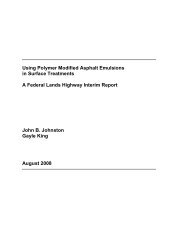Spray Applied Polymer Surface Seals - TSP2
Spray Applied Polymer Surface Seals - TSP2
Spray Applied Polymer Surface Seals - TSP2
You also want an ePaper? Increase the reach of your titles
YUMPU automatically turns print PDFs into web optimized ePapers that Google loves.
What do we know about Fog <strong>Seals</strong>?<br />
Low cost preventive maintenance<br />
• 13 cents to $1.60 per square yard<br />
Emulsion must infiltrate HMA surfaces<br />
• Fog seal<br />
Light application of dilute asphalt emulsion<br />
Hard residue meant to bind or seal<br />
• Rejuvenating fog seal<br />
Light application of dilute oil or oil/asphalt emulsion<br />
Alter rheology of oxidized asphalt near the surface<br />
Fog and rejuvenator seals are the least expensive preventive maintenance surface<br />
treatments designed to protect and prolong the life of good pavements. Several<br />
different types of sealers and rejuvenators are readily available in the marketplace.<br />
Sealers such as SS-1 (Slow Setting emulsified asphalt) or CSS-1 (Cationic Slow<br />
Setting emulsified asphalt) are commonly used to “seal” the pavement surface or to<br />
“bind” or “lock” cover material or fines in-place reducing surface attrition.<br />
Rejuvenators are designed to penetrate into the existing asphalt cement and modify<br />
and improve existing chemical and rheological properties. The product selection is<br />
dependent upon the problem being solved and the existing pavement type.<br />
Rejuvenator products are most typically used on dense-graded asphalt surfaces,<br />
while fog seal products are more commonly used on chip seals and friction courses<br />
where binding or enrichment is the main purpose. However, both product types<br />
have been used on all three surface types.<br />
In the embrittlement process of flexible pavements, the oxidation of asphalt occurs<br />
during both construction and the service life of the pavement. Asphalt hardening<br />
during construction can be predicted by laboratory aging procedures, allowing<br />
adjustment of the initial binder rheology for typical changes during hot mix asphalt<br />
(HMA) mixing and compaction. The long-term aging of the asphalt is much more<br />
difficult to predict. It depends upon the asphalt crude source, the environment and<br />
available oxygen as supplied through interconnected air voids. Sealers and<br />
rejuvenators are used in a preventive maintenance strategy to prevent surface<br />
asphalt from reaching the limiting stiffness where surface cracks begin to appear. If<br />
cracks develop, the aging accelerates due to infiltration of moisture and oxygen.<br />
Rejuvenators were developed in the late 1950s to prevent age-induced block<br />
cracking by softening hardened binders.<br />
Some agencies, however, have discontinued or limited the use of fog and<br />
rejuvenator seals because of loss of skid resistance. This study was initiated to<br />
11
















